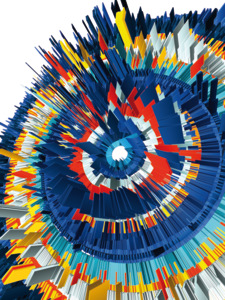Marius Watz
*1973 in Oslo, currently lives in Oslo and New York
Ausstellungen/Exhibitions:
“From Kinetic to Digital Art”, Fondation Vasarely, Aix-en-Provence / “Artomaton”, Mediaruimte,
Brussels / “Decode”, Victoria & Albert Museum, London / “System:system”, Brooklyn /
“KIOSK”, STRP Festival, Eindhoven // Watz is represented by [DAM]Berlin
Work: www.unlekker.net
Blog: www.generatorx.no
Play: www.evolutionzone.com
Object #1-3
2007, 3D printed objects in white resin
Courtesy of [DAM]Berlin
Die „Objekt“-Serie erforscht die möglichen Gebrauchsweisen generativer Softwareprozesse für die Produktion materieller Objekte. Die 3D Druck-Technologie ermöglicht die genaue Übertragung von Objekten, die im immateriellen Raum des Computers erzeugt wurden in deren materielle Manifestationen. Die Voxel (3D Pixel) Logik, die in diesen Prozessen verwendet wird umgeht Einschränkungen in Verbindung mit traditionellen Herstellungstechniken und erlaubt dadurch die bedarfsmäßige Herstellung von Objekten von bisher unvorstellbarer Komplexität. Gleichzeitig beseitigt dies die statische Form oder das ursprüngliche Objekt wie es bis dahin typisch war für Massenproduktion. Stattdessen wird eine digitale Repräsentation hergestellt, die mit Leichtigkeit jedes Mal aufs Neue unterschiedliche Ergebnisse produzieren kann. Da die Herstellung von einzigartigen Objekten um nichts teurer ist als die einer Folge von identischen Kopien werden die ökonomischen Einschränkungen von Massenproduktion redundant. Massenproduktion muss damit der Massenmaßanfertigung weichen. Objekt#1-3 sind Antworten auf diese neue Art der Anfertigung. Ein einfaches parametrisches Software-System vermag es, unendliche Variationen gemäß einer einfachen generativen Logik herzustellen: Formen werden dadurch sichtbar gemacht, dass ein sphärisches Modell auf beliebige Weise im virtuellen Raum des Computers in Segmente zerschnitten wird. Diese werde danach in Gruppen von extensiven Bögen und freistehenden Abschnitten zusammengefügt. Indem die Parameter, die die formalen Prioritäten kontrollieren, manipuliert werden, wird es möglich, eine Vielzahl an Formen herzustellen – offene wie geschlossene, harmonische wie chaotische.
The “Object“-series is an investigation into the use of generative software processes for the production of physical objects. 3D printing technology enables the literal translation of objects created in the immaterial space of the computer into physical manifestations. The voxel (3D pixel) logic used in these processes bypasses restrictions associated with traditional manufacturing techniques, allowing for the on-demand fabrication of objects of previously unimaginable complexity. At the same time this does away with the static mold or original object previously typical to mass production, instead using a digital representation that can easily produce different outcomes every time. As the creation of unique objects is no more costly than series of identical copies, the economic restrictions of mass production become redundant, giving way instead to mass customization. Object #1-3 is a response to this new manufacturing situation. Here a single parametric software system is capable of producing infinite variations on a single generative logic: Forms are articulated in the virtual space of the computer by randomly slicing a spherical model into segments. These are then assembled into a cluster of sweeping arcs and freestanding sections. By manipulating the parameters which control the formal preferences of the program, it becomes possible to produce shapes that range from open to closed, from harmonious to chaotic.


